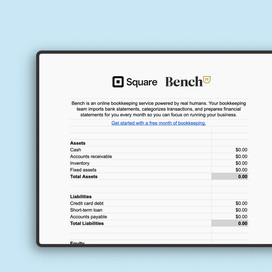Table of contents
For business owners moving money quickly to your bank account can make the difference in whether or not you pay your bills on time. You can use bank transfers to move around funds, to accept payments from a customer, to pay taxes associated with your business, and to pay suppliers.
What is a bank transfer?
A bank transfer is a payment method that allows consumers and business owners to transfer money to a bank account. For business owners this will typically happen when you are looking to transfer money from sales related to your business to a business bank account.
If you use Square for your business, there are several types of transfers available:
- Standard next-business-day transfer: When you activate your Square Point of Sale account, link a bank account, and start to accept payments, funds will transfer on a standard schedule, from 36 hours to one to two business days within a transaction.
- Instant transfer: If instant transfers are available on your account, you can send funds to your linked, external bank account 24 hours a day, seven days a week, for a 1.75% fee per transfer. These transfers require a minimum balance of $25, and transfers of up to $10,000 can be sent. Balances not sent instantly will be sent on your normal schedule.
- Same-day transfer: Same-day transfers are also available for a 1.75% fee per transfer and are the most similar to instant transfers. These transfers are available to transfer your funds at close of day on an automated schedule you choose. You can send multiple payments as large as $10,000 with same-day transfers, but payments above that amount must be sent by next-business-day transfer.
Square Checking offers a checking account that gives you instant access to your sales with Square. You can use its account and routing numbers to allow third parties to debit your Square balance using ACH at no additional cost to complete payments for things like bills or expenses.1
Why do business owners use bank transfers?
Bank transfers are a quick and easy way to send or receive money, so many business owners use them in order to move funds between accounts, to pay taxes or to pay suppliers. Bank transfers are an alternative to paper checks or cash. They can make payments efficient for large amounts since they can be processed electronically. Banks also offer a record of transactions, so business owners can check which payments were made at what time or even set payments automatically. Finally, unlike some alternatives to moving funds, bank transfers can help build credit.
Are there bank transfer limits?
When it comes to transferring money to any external bank account, the dollar amount limit — as well as the speed of transfer — will depend on the banks involved in the transfer and the type of transfer itself. Here are some common bank transfer limits and Square transfer limits.
Bank transfer limits
| Type of transfer | Transfer limit |
|---|---|
| ACH Same Day transfer | Up to $1,000,000 |
| Bank of America Corp. | $3,500 per day or $10,000 per week |
| JPMorgan Chase & Co. | Up to $25,000 per day |
| Citigroup Inc. Standard ACH | Up to $10,000 per day |
| Capital One Financial Corp. | Up to $10,000 per day or $25,000 per month |
Square transfer limits
| Type of transfer | Transfer limit | Speed of transfer |
|---|---|---|
| Standard next business day | None | 1 to 2 business days. |
| Instant transfer | Up to $10,000 | Instantly 24 hours a day, 7 days a week. |
| Same-day transfer | Up to $10,000, however, your transfers can be sent in more than one batch as long as no individual transaction is greater than $10,000. | Daily at 5:15 p.m. PT / 8:15 p.m. ET or 15 minutes after your close-of-day time. |
What is the difference between a wire transfer and a bank transfer?
While wire transfers and bank transfers are both types of electronic funds transfers (EFT), they do have some key differences.
Wire transfers are often thought of as electronic checks — as soon as a transfer is started, it is taken out of your account. Unlike a bank transfer, a wire transfer doesn’t require bank accounts to be linked to one another in order to transfer funds. These types of transfers often come with a fee that can range depending on the payment service of the bank involved in the transfer.
Bank transfers can be sent from one internal account to another, from your bank account to an external account, and from your payments processing account to your bank account. These transfers typically cost less as they require lower fees (if any fee at all), but they do come with limits on the dollar amounts per transfer as well as the number of transfers you can send.
Is a bank transfer secure?
Bank transfers are considered a safe and secure method of payment, as there is proven identity verification associated with the transfer itself. However, it is critical to ensure that you know the person to whom you are sending the money. Whether you are initiating a bank transfer to an external bank account or to a different account within your own bank, double check the name of the recipient. Once a transfer is initiated, it cannot be canceled. As with other digital banking functionalities, the alternative could be less secure. Transferring funds to a bank account in cash form includes the steps for transporting money yourself and any security risks involved with moving that money physically from one location to another.
Is a bank transfer the same as ACH?
ACH payments and bank transfers are two ways you can move money quickly and easily as a business owner. ACH payments, which stands for Automated Clearing House, are used for electronic payments, money transfers, and direct deposits. They can transfer money directly from one account to another without using other means of payment, such as paper checks, credit card networks, wire transfers, or cash.
Bank transfers are a catch-all term to account for different types of transfers in which a bank is involved in the movement of those funds. Both ACH and wire transfers are types of bank transfers. While all ACH payments go through the Automated Clearing House, they can be used to make payments between banks and credit unions. In fact, an ACH transfer is a type of domestic bank transfer.
1New Square sellers may be limited to $2,000 per day. Funds generated through Square payment processing services are generally available in the Square balance immediately after a payment is processed. Funds are subject to your bank’s availability schedule but are generally available in your bank account within 20 minutes of initiating an instant transfer.
![]()












